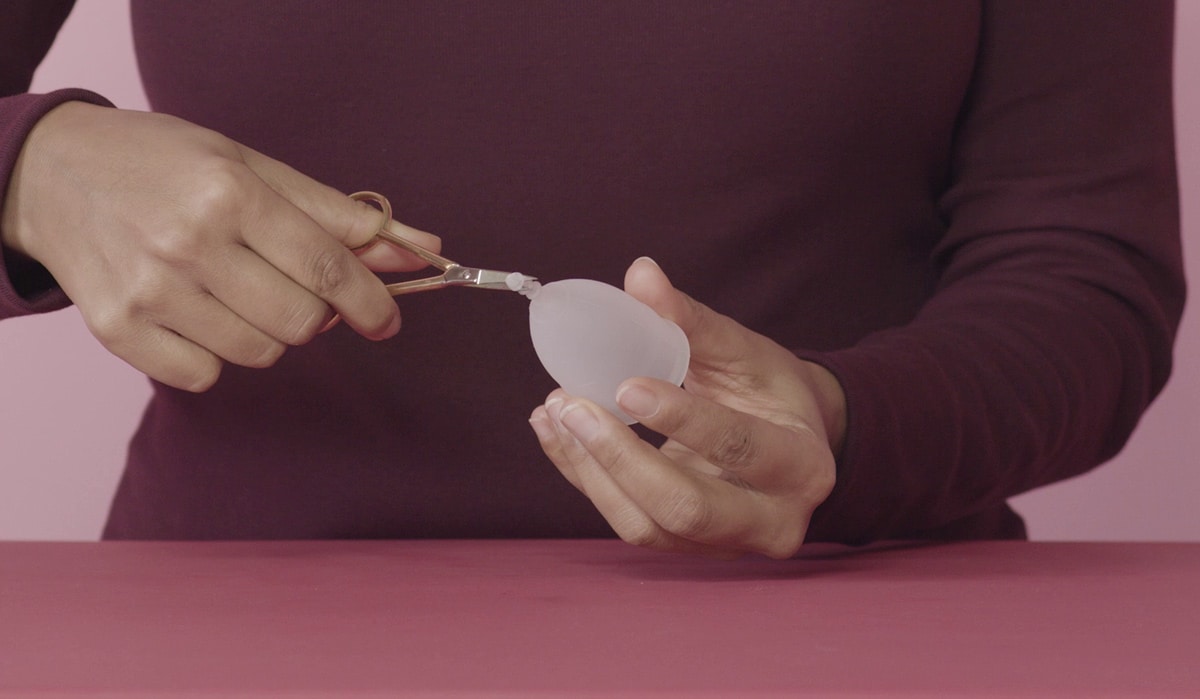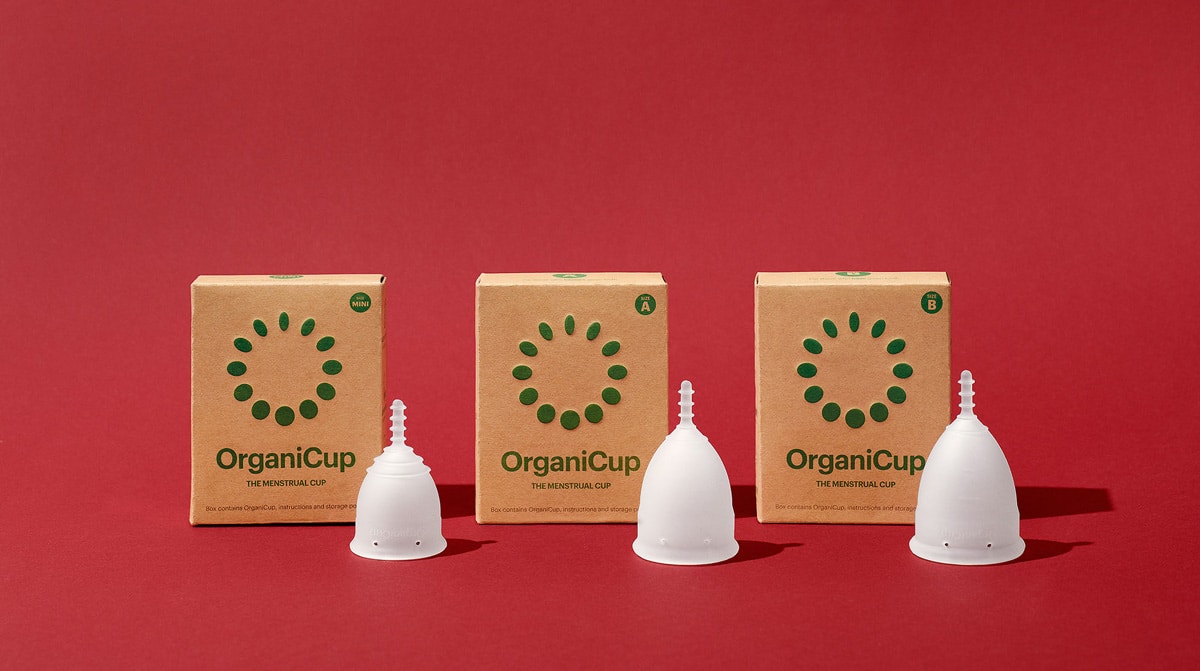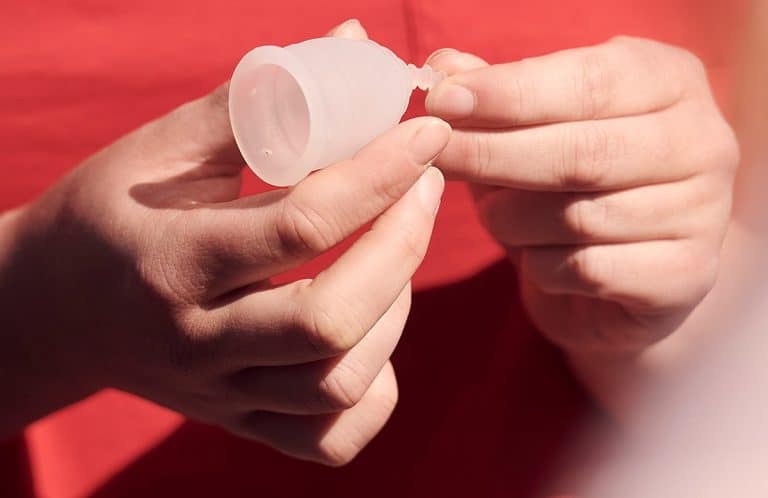I’ve tried the OrganiCup menstrual cup and rated it the best of 2020

By Alma Fabiani
Published Oct 6, 2020 at 01:45 PM
Reading time: 9 minutes
In partnership with OrganiCup
Ever wanted to ditch your tampons and pads for a menstrual cup? If so, you’re not the first one who thought about it, yet never took the plunge. That’s why I tried the most sustainable one out there during my last period, the OrganiCup, to review it, just for you. From cup size to tips on its usage and what sporty activities you can do without a worry in sight, here’s everything you need to know about my best rated menstrual cup of 2020: the OrganiCup.
What is a menstrual cup?
Let’s start by explaining what a menstrual cup is, as some of you might not be familiar with the somewhat recent period product. If you’ve already been through the whole experience of getting your period for the first time, switching from pads to tampons while always worrying about a potential leak, then you might want to consider the menstrual cup as an alternative.
A menstrual cup is a soft, medical-grade silicone or rubber cup that is inserted into the vagina to catch the blood flow, just like a small vessel. Once inserted, you’ll only need to empty your cup every 8 to 12 hours, rinse it under some water, and put it back in. It’s that simple!
Unlike pads and tampons, the menstrual cup is reusable and can last for a couple of years. This means that in the long-term you will save a lot of money by not having to purchase pads or tampons every month. Tampons packs range between £3 and £9 depending on blood flow, type, brand and number of tampons per pack. A menstrual cup such as the OrganiCup only costs £21 for years of usage.
No need to do the math, trust me, this is a win-win situation. Plus, if inserted correctly, not only will your cup feel perfectly comfortable but it will not leak or spill, which has always been something I’ve previously struggled with. Menstrual cups are also much better for the environment, as they allow you to drastically cut down on the number of menstrual products you use but I’ll get back to that shortly.
How to use a menstrual cup
When I finally decided to give menstrual cups a go, I dreaded one thing: the first use. Just like tampons when I was younger, I feared it might get stuck in the wrong angle and just bother me all day. Being the know-it-all that I am, I wanted to be sure I would insert my new menstrual cup the right way on the first try.
Why? Because, for some reason, I thought it would be more complicated than inserting a tampon or sticking a pad on my comfy period knickers. Well, let me tell you, it wasn’t—I actually didn’t struggle with it one bit, which made me very pleased with myself. Here’s exactly how to insert a menstrual cup.
How to insert a menstrual cup
My OrganiCup came in a small box that contained all the instructions I needed. After reading these, I even found a cute video that showed all the details and answered any extra questions I had about the folding of the cup.
First things first, keep in mind that inserting a menstrual cup (or any other kind of period product) for the first time is bound to be a different experience for whoever tries it. Don’t worry though, it really is as easy as it comes! Before your menstrual cup’s first use, make sure you thoroughly wash it by sterilising it in boiling water for 3 to 5 minutes. Don’t let the cup touch the bottom of the pot as this might melt it.
I know, boiling a menstrual cup doesn’t sound too sexy right now, but it will only take you a few minutes and will definitely be nicer than emptying a bin full of tampons. Once your cup is sterilised and dried up and your hands are squeaky clean too, now is time to think about how you want to insert it.
You’ll need to fold it to get it up there, and there are a few different folding techniques you should keep in mind. Two of the most popular are the ‘punch-down fold’ and the ‘C-fold’. While the C-fold consists of folding your cup by pressing both sides of it so it looks like the letter C, the punch-down fold definitely felt like the easier method. As you can see in OrganiCup’s instructive video, the punch-down method only folds one side of the cup by pushing it all the way in, making your cup look almost like a tiny funnel.
This technique provides the smallest diameter, meaning it makes insertion easier, which is why I would recommend the punch-down fold! After picking whichever insertion method you feel most comfortable with, remember to keep it folded with your fingers while inserting it. Once it’s inside of your vagina, just let go babes.
When inserting it, I personally just stand up with one leg slightly opened but you can also try to insert your menstrual cup while squatting, sitting on the toilet or even laying down. The main thing to keep in mind is to stay relaxed—if you’ve previously used tampons, you’ll know how being tense can mess up the whole insertion process!
Where should a menstrual cup sit?
Okay, now let’s get into details. Once you’ve inserted and let go of your menstrual cup, the entire cup, opened up, should be inside of you. If you’ve inserted it correctly, you might hear a suction sound or feel it pop open, which would mean that the cup has unfolded and created the necessary suction seal. No worries if you don’t hear any sound, I didn’t either.
If you’re in doubt, just have a little feel inside to check if the base of the cup is round and doesn’t have any folds. If it does, you might have inserted your menstrual cup the wrong way and it might end up leaking at one point. If you feel any folds on the base of your cup, simply gently grip the base of the cup (not the little stem sticking out) and rotate it to make it unfold.
After you’ve tried this, pull the stem a bit. If you feel the suction or a little resistance, then congrats, you’ve inserted your cup correctly! You could also wiggle around the room a little bit as the cups sometimes pop open on their own in there with some movement. See, that wasn’t so hard, was it?
How to remove a menstrual cup
While your menstrual cup’s stem should be completely inside of you, in comparison with a tampon, a cup should be placed lower in the vaginal canal. This means that when you need to take it out, you simply have to reach for the small stem—with clean hands, please! If that stem is sticking out after you’ve inserted your cup, you can cut the end of it as much as you need to, because every body is different!

For me, as a complete period freak who used to change my tampons every hour although I never needed to just because my paranoia got the best of me, the OrganiCup is a life-saver because you only need to change it twice in a day: once in the morning, and once in the evening. Here again, everyone is different, so depending on how heavy your flow is, you might have to empty your cup more than twice a day. To be sure of that, just empty your menstrual cup more often at first to get an understanding of your flow.
When removing your menstrual cup, make sure you relax, then pull on the stem only until you can reach the base of your cup and pinch it slightly to release the suction seal and ease it out. This should be obvious but sometimes people just forget to think—like me—so be careful enough to take your cup out without tilting and spilling it all over your bathroom floor. Once emptied, wash your cup and reinsert it if you’re still on your period.
How to clean a menstrual cup
My menstrual cup’s sterilisation process was probably the one aspect that resulted in the most questions from my friends. Do you actually have to boil it? Do you have to do it every time you take it out? Isn’t it melting everywhere? One went as far as to ask me if I ‘cook it’ in my usual cooking pot. In other words, people seemed to be pretty curious (and clueless) about a menstrual cup’s sterilisation process.
Let’s be clear on one thing: you don’t cook your menstrual cup, you sterilise it, which means by boiling it, you make sure that any bacteria on it gets killed—you disinfect it, basically. Menstrual cups are actually way cleaner than pads and tampons, which often contain hazardous chemicals. With cups, no external factors or free oxygen reach the accumulated flow while it is inserted, which means no bacteria is created—the same can not be said about tampons. Did you, like my younger self, read the small prints at the back of your tampons’ box? Scary.
At the end of your period, just boil your cup for 3 to 5 minutes once the water reaches 100 degrees Celsius, make sure it doesn’t touch the bottom of your pan and keep it in the OrganiCup cotton bag that comes with it until your next period comes. You only need to sterilise your menstrual cup at the beginning and at the very end of your period, not every time you empty it.
Which size of menstrual cup should I go for?
OrganiCup offers three different cup sizes: mini, A and B. While different menstrual cup brands offer different sizes, I found that OrganiCup’s sizes were the simplest ones to pick from. I even took the Size Quiz on OrganiCup’s website to make sure I chose the correct size.

The Mini, which is usually recommended for teens, has a cup length of 58 millimetres, while the size A, which is recommended for those who have not given birth vaginally, has a cup length of 65 millimetres. I went for size A, which worked perfectly for me. Size B has a cup length of 70 millimetres and is recommended for those who have given birth vaginally.
Although it might seem surreal that your menstrual cup never gets too full during 12 hours, according to the NHS, on average you only lose 5 to 12 teaspoons of blood during your period.
What kind of activities can I do with a menstrual cup?
Sleep, run, swim and dance—I pretty much did everything I could with my menstrual cup, and so can you! I’ve always been an active person, so my period products need to be fitted to my activities. However, even with tampons, sometimes going for a swim could result in an unfortunate leak. Unknowingly, this led me to avoid doing too much while on my period.
Well, no more! Because I wanted to fully review my new menstrual cup, I decided to go for a swim on the second day of my period, just to test it out. In these pandemic times, the pool was quite empty anyway, so why not? The suction that the cup provides allowed me to do whatever I felt like doing. While the OrganiCup might feel a bit thicker than other menstrual cups out there, this allows it to stay in place all day long, no matter what activities you’re planning on doing.
So, to answer your question, from sporty activities such as running, swimming or even horseback riding, to more ‘period-appropriate’ activities like laying on your sofa and eating chocolate at three in the morning, you’ll be able to do anything you wish in your OrganiCup—and you won’t even have to worry about changing it every 4 hours!
What is the best menstrual cup?
While you can guess by the title of this article that the OrganiCup is the menstrual cup I would personally recommend, I’d like to offer some extra reasons on why exactly I prefer it to other cups. Menstrual cups in general first caught my eye because of the obvious environmental positives they represent. Did you know that pads and tampons take 500 years to degrade? Meanwhile, the OrganiCup is reusable for years and has a minimal impact on the environment. More specifically, the OrganiCup’s packaging is as sleek as it is compact and eco-friendly—the cup’s instructions are printed on the inside of its box, which is made of recycled paper, so as to not waste any additional paper.
After receiving my own menstrual cup, not only did I find myself lost on OrganiCup’s website because of how in-depth its content is but also because it helped me feel better about my period. As someone who’s always had irregular periods, OrganiCup’s ‘Your Period’ category contained everything I expected from a period product company. From explaining what you should expect from your first period to a piece covering irregular periods and what can cause them, OrganiCup’s website offers the kind of advice people who menstruate should be given throughout their life—but never are. Knowing that 1 in 5 girls and young women in the UK are bullied about their periods, maybe it’s time we seriously consider revisiting menstrual education in 2020.
OrganiCup goes even further than sharing its knowledge of menstruation and the female anatomy by also putting great effort into helping women in difficult circumstances who might not have access to proper period products in the first place. Period poverty in developing countries has for long been a known issue which forced girls to use make-shift solutions to manage their periods. To put things into perspective, 1 in 10 African girls miss school during their period, which eventually leads to a higher school dropout rate.
In order to tackle this problem, OrganiCup has partnered with many NGOs, both in developing and developed countries, to ensure those in need receive proper education about menstrual health and have access to period products.
So yes, the OrganiCup is a cleaner, safer, cheaper alternative to other types of period products, it is also way better for the environment but on top of that, the brand gives back! And let’s be honest here, we all buy into the brand, right?
My last tips for menstrual cups beginners
– When cleaning your menstrual cup before reinserting it, rinse it in cold water first to get rid of the blood in order to avoid staining it. Rinsing it with hot water might lead to staining after a while.
– Beware of the cup’s vacuum when taking it out. Make sure you first release a bit of pressure before pulling your menstrual cup out, otherwise pulling on it might be painful.
– If your cup’s stem is sticking out and bothering you, don’t be afraid to cut it as much as you need to. I was hesitant to do so at first, worried my cup might just get swallowed completely but once I took the plunge, I really felt a difference. Just cut it when you’re not using your cup.
– When going out, make sure you also add a few cleaning wipes in your bag as you might end up using toilets that unfortunately don’t have a sink for you to rinse your cup.





